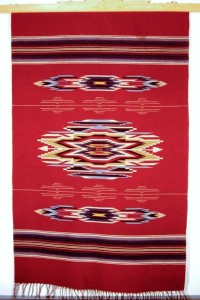Chimayo
Chimayo is the style that Irvin and Lisa learned first, before learning to weave the older parts of the tradition. There is a logic and a mindset that is central to weaving the Chimayo style. And there’s all of that going back and forth between shuttle weaving and tapestry weaving. It may be the first style that we learned to weave, but it isn’t necessarily an easy thing to do.
Let’s start by describing and defining the style the best we can. A Chimayo has two stripes and a center design. The bigger the piece is, the more room there is to add more elements. There are secondary designs, and jaspes one can add to give it more visual interest and fill the space. The stripes are very much like Rio Grande stripes, and you can think of the center design as a variation on a Saltillo diamond, but sort of squished down so that it is wider than it is tall.

There are a group of pieces, and they aren’t commonly found nowadays, that have been called “prototypical Chimayos”. These pieces are most commonly red, with black and white designs. They can be seen as spanning the design distance between the Saltillos with dispersed elements and/or corner elements, and the Chimayo blanket that settles in in the 1920’s
The weavers all became specialized, some weaving on big looms, and some on small looms. We are told that the men working on the big looms got very competitive over their designs. So we see a lot of very creative ideas spring up, and a huge variation in Chimayo designs. There is something of a golden age in Chimayo weaving in those early years, the 1920’s and 1930’s, and we have much to learn from those early Chimayos.

